‘My Bloody Valentine 3D’
- Share via
It’s no exaggeration to say that among the stars of “My Bloody Valentine 3D” is the process by which the film is rendered to appear three-dimensional. For those with memories of the original “House of Wax,” “Jaws 3-D” or “Comin’ at Ya!” the difference is hard to believe.
Working with the company Paradise Effects and stereographer Max Penner, the filmmakers created the effect with technology that such earlier 3-D practitioners as schlockmeister William Castle could never have dreamed of. The film was shot using the digital Red camera, famously used as a prototype on Steven Soderbergh’s “Che,” allowing for much greater control between the two images used to create the 3-D effect. And though, yes, there are still glasses, they now look more or less like a pair of Wayfarers, and not like the cornball cardboard red-and-blue ones that have become the stuff of ‘50s nostalgia stereotypes. The headaches that many remember from 3-D movies is a genuine physiological response to what is needed to trick the eyes into “seeing” 3-D, and director Patrick Lussier and his team worked hard to counteract the complaint.
“We literally go through every single frame of every single shot and do all the correct alignments and correlations to make sure your left eye and your right eye are not only in sync, but vertically aligned,” explained Lussier. “All the things that could give you headaches or stress are removed. It’s a completely immersive experience that becomes part of the storytelling, and not just a gimmick to rip your brain open.”
More to Read
Only good movies
Get the Indie Focus newsletter, Mark Olsen's weekly guide to the world of cinema.
You may occasionally receive promotional content from the Los Angeles Times.











